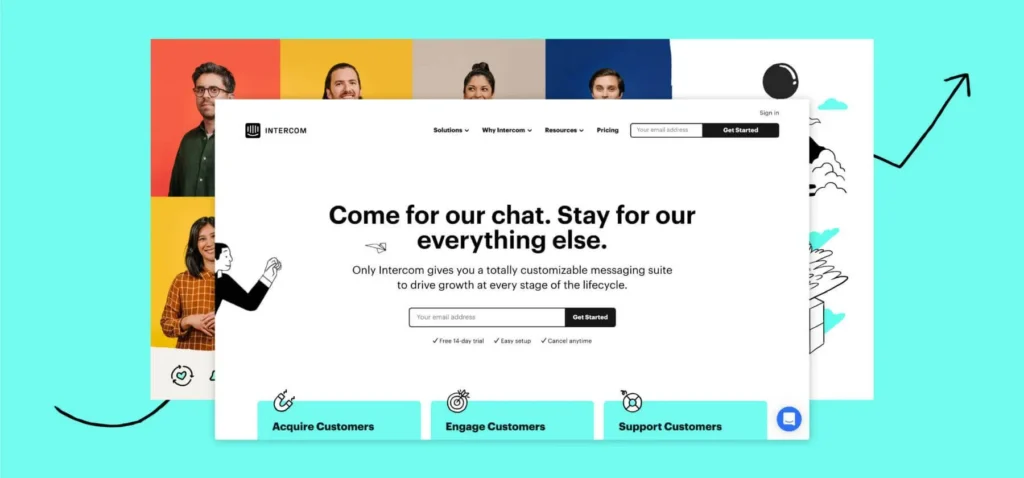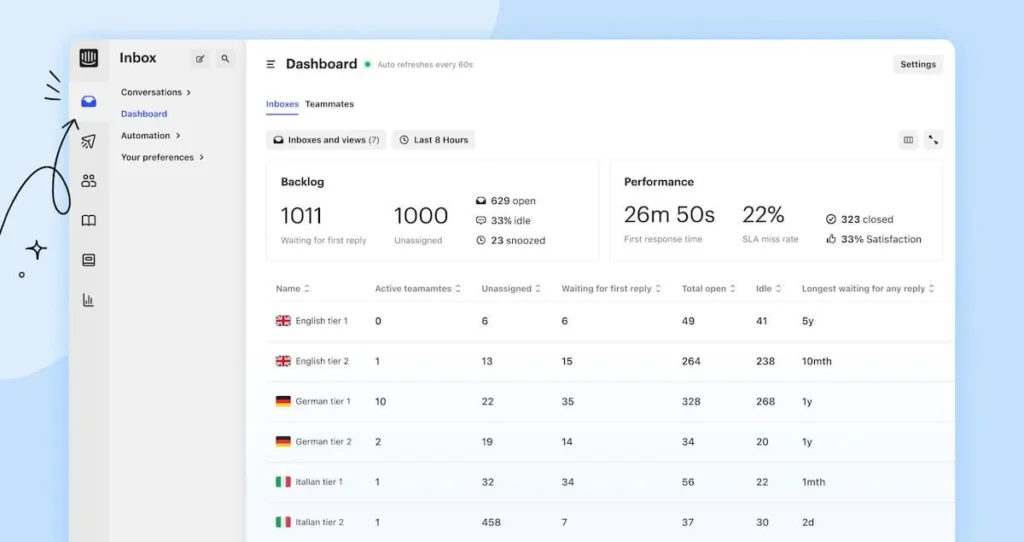
Hello, growth enthusiasts!
Today, we’re diving deep into the growth story of Intercom –the customer communication platform that has changed how businesses connect with their audience.
With a $1.3 billion valuation, over 25,000 paying customers, and 600 million monthly active users, Intercom has cemented its position as a true SaaS unicorn.
But how did this Dublin-based startup go from a simple idea to a customer communication leader?
In this playbook, we’ll reveal the secrets behind Intercom’s growth, from their early days to their current status as a market leader.
The Idea

It all started with a spark of inspiration in a cozy Dublin coffee shop.
The 4 Intercom founders noticed how the shop owner has built customer loyalty through personalized, one-on-one interactions.
At the time, the founders were running a software company called Exceptional and realized they hardly knew their own customers.
They wondered:
Could businesses build those same authentic, personal relationships with their customers online, just like the coffee shop owner did?
And just like that, the seed for Intercom was planted – a platform that would enable businesses to communicate with their customers in a more human way, building real life connections in the digital age.
The Problem 

In the early 2010s, the online business landscape was a bit of a mess.
Customer communication was often impersonal, transactional, and downright frustrating.
Businesses struggled to connect with their customers in a meaningful way, relying on generic email blasts and clunky support systems that left customers feeling unheard and undervalued.
The Intercom team saw firsthand how this disconnect was hurting businesses and customers alike.
They knew there had to be a better way – a way to bring the warmth and personalization of face-to-face interactions to the digital world.
The challenge was clear: humanize online customer communication.
The MVP 

With the vision set, the Intercom team got to work on building their Minimum Viable Product (MVP).
Their goal was to create a simple yet effective way for businesses to communicate with their customers in real time.
The MVP took the form of a small piece of code that businesses could easily install on their website.
This code would display a discreet “Talk to us” button, allowing visitors to start a conversation with the company at any time.
To power this feature, the Intercom team developed an admin tool that enabled businesses to manage and respond to customer inquiries quickly.
The tool also provided valuable insights into customer behavior and preferences.
While the MVP was a far cry from the feature-rich platform Intercom is today, it effectively demonstrated the value of real-time, personalized customer communication.
Product-Market Fit 
Intercom’s journey to product-market fit was a defining moment in their growth story.
The team had a promising MVP, but they needed to validate their assumptions and ensure they were building a product that truly resonated with their target audience.
To achieve this, Intercom leveraged their existing network of clients from their previous company, Exceptional.
By offering these businesses early access to the Intercom platform, they gathered valuable feedback and insights.
To dive deeper into understanding their customers’ needs, Intercom turned to the Jobs-to-be-Done (JTBD) framework.
Through extensive customer interviews and data analysis, they uncovered the key “jobs” their customers were trying to accomplish, such as building better relationships, providing personalized support, and gaining customer insights.
Armed with this knowledge, Intercom refined their product to better address these specific needs, introducing features like automated messaging and customer data management.
By combining early traction with deep customer insights, Intercom found their product-market fit and set the stage for rapid growth.
Positioning & Branding 


Intercom’s positioning centered around one core idea:
Making internet business personal.
They wanted to be known as the company that helped businesses build genuine, human connections with their customers in the digital age.
To bring this positioning to life, Intercom used a distinctive brand voice that was warm, friendly, and approachable.
They infused their marketing materials and product design with personality, using emojis, illustrations, and conversational language to create a sense of authenticity and relatability.
Intercom’s branding efforts extended beyond visual elements.
They actively participated in industry events, sharing their thought leadership and expertise in customer communication.
They also published valuable content on their blog, establishing themselves as a go-to resource for businesses looking to improve their customer relationships (more on that later).
By consistently communicating their positioning and values through their branding, Intercom was able to build a strong emotional connection with their target audience and differentiate themselves in a crowded market.
Pricing 


Pricing was a critical component of Intercom’s growth strategy.
They aimed to strike a balance between making their product accessible to businesses of all sizes and generating sustainable revenue.
In the early days, Intercom offered a basic subscription plan starting at $49 per month, which included core features like live chat and targeted messaging.
As their product matured, they introduced more advanced plans and add-ons to cater to the needs of larger enterprises.
Intercom’s current pricing model includes an Essential plan at $39 per month, with higher-tiered plans (Advanced and Expert) providing additional features and customization options.
Intercom also offers add-on products for $99 per month and advanced features like their Fin bot, with prices available upon request.
By offering a range of pricing options and the ability to scale up or down based on a company’s needs, Intercom has been able to attract and retain customers of various sizes, from startups to large enterprises.
Acquisition 
Intercom’s acquisition strategy has been focusing on organic channels and a targeted approach to paid acquisition.
Organic Acquisition
Intercom’s organic acquisition efforts have been driven by their strong content marketing and SEO performance.
Their blog, “Inside Intercom,” has been a key driver of organic traffic, attracting readers with high-quality, informative content that resonates with their target audience.
According to Des Traynor, co-founder of Intercom, content marketing has been at the core of their customer acquisition strategy since the early days of the company.
In a comment on Hacker News, he stated:
“Content Marketing (which is a fuzzy term for writing blog posts) is the majority of our acquisition. What that means is that if someone signs up to Intercom, the majority of the time, they came from a blog post.“
Paid Acquisition and Retargeting Ads
While Intercom has focused heavily on organic acquisition, they have also invested in paid channels to support their growth.
One of the most effective tactics they’ve employed is retargeting ads on Facebook.
Intercom understands that not every website visitor is ready to sign up for their product right away.
That’s where retargeting comes in.
By showing ads to people who have already shown interest in their product, Intercom was able to stay top-of-mind and encourage those visitors to come back and give their free trial a shot.
By emphasizing the free trial in their retargeting ads, Intercom was able to lower the barrier to entry and make it easier for potential customers to give their product a try.
This approach has proven effective in converting website visitors into trial users and, ultimately, paying customers.
The Results
Through their focus on organic acquisition and targeted paid efforts, including retargeting ads, Intercom has achieved significant growth and established themselves as a leader in the customer communication software space.
Their content marketing strategy has allowed them to attract a large and engaged audience, while their retargeting ads have helped convert website visitors into loyal customers.
Growth Loops 

The most effective loop they’ve leveraged is the embedded growth loop.
The Embedded Growth Loop
Here’s how it works:
- A user visits a website that uses Intercom’s messaging widget
- The user notices the “We run on Intercom” message on the widget
- Intrigued, the user clicks on the message and is taken to a dedicated Intercom landing page
- The user learns more about Intercom and signs up for the service, and the loop goes on
It’s a simple yet powerful process that turns Intercom’s existing customers into a distribution channel for their product.
Every time a customer adds Intercom’s messaging widget to their website, they’re essentially becoming a brand ambassador, exposing their visitors to Intercom’s brand and product.
The beauty of this growth loop is that it scales with Intercom’s customer base.
As more companies adopt Intercom’s messaging platform, the number of potential users exposed to the “We run on Intercom” message grows exponentially.
But Intercom didn’t just stop at the “We run on Intercom” message.
They took it a step further by creating dedicated landing pages for each customer, complete with the customer’s logo and a personalized headline.
This attention to detail makes the user experience feel more tailored and trustworthy, increasing the chances of conversion.
By leveraging their customers’ websites as a distribution channel, Intercom has been able to tap into a powerful growth loop that continuously brings in new leads and customers.
Activation 


For Intercom, activation is an ever-evolving journey built around their CARE framework:
Conversion, Activation, Retention, and Expansion.
Their dedicated product education squad is the driving force.
“Product education bonds customers to our product from day one,”
shares Ruairi Galavan, Director of Customer Engagement.
“It allows us to service them at scale, efficiently.”
The activation arm hits the ground running with every launch, creating educational campaigns spotlighting new features.
But they don’t stop there!
The real magic happens through “small touches” that nurture long-term engagement – targeted in-app messages, friendly nudges, bite-sized tutorials.
Intercom’s sales team also plays a key role in onboarding and activating larger accounts through high-touch support.
The goal?
Make product education feel seamless, constantly earning users’ attention by delivering undeniable value at every stage of the CARE journey.
Retention 

Retention is where Intercom truly flexes its product education prowess.
Their strategy focuses on keeping users engaged and “stickier” longterm.
First up are those clever contextual upsell pathways and in-app suggestions subtly nudging users to unlock more value.
But these aren’t one-size-fits-all automations – they’re precisely tailored based on each user’s data and observed behavior within the product.
Intercom’s sales team also gets in the game for higher-value accounts, providing white-glove support and encouraging deeper product adoption through targeted messaging and hands-on training customized to each account’s needs.
But Intercom’s genius lies in understanding that the more functionality a user embraces, the stronger their retention moat becomes.
Accounts with broader product usage have massively higher LTV and drastically lower churn rates.
It’s a retention goldmine!
That’s why Intercom thoughtfully segments its approach based on account size and behavior.
Self-service flows nurture smaller users through automated education personalized to their usage patterns.
For whales, it’s a high-touch, red carpet experience complete with expert guidance from seasoned reps.
Either way, the endgame is turning users into rabid Intercom superfans – the kind who can’t imagine life without the platform and eagerly sing its praises.
By crafting this data-driven, hyper-personalized strategy that spans product, sales, and customer education, Intercom has mastered long-term retention.
It’s a masterclass in maximizing lifetime value!
Referral 


While Intercom doesn’t have a traditional referral program, they’ve cooked up a clever alternative: the Service Partner Program.
This initiative allows agencies, consultancies, and BPOs to team up with Intercom, earning commission for every client they refer.
But the benefits go far beyond just referral fees.
Partners get exclusive access to Intercom’s expertise, allowing them to become certified messaging masters.
They can integrate Intercom into client strategies, deliver innovative customer experiences, and ultimately drive growth for all parties involved.
It’s a win-win-win that transforms Intercom’s service providers into an extended sales force.
After all, who better to spread the Intercom gospel than those witnessing its power firsthand?
Lessons Learned 
Here is a summary of the secrets behind Intercom’s growth.
Leverage Content Marketing
Intercom recognized the potential of content incredibly early on. By producing high-quality, audience-focused content on their “Inside Intercom” blog, they built an empire of organic traffic and established themselves as trusted experts.
Master Growth Loop Mechanics
The embedded growth loop was Intercom’s not-so-secret weapon. Every new customer added the messaging widget to their site, exposing their visitors to Intercom and continuously fueling their acquisition engine. Sheer brilliance!
Prioritize Customer Obsession
From day one, Intercom obsessed over customer success. Every strategy, every hire centered on delivering exceptional value. This unswerving commitment was their guiding star.
Double Down on Product Education 
Most startups neglect it, but Intercom invested heavily in a world-class product education squad. This powerhouse team laser-focused on activation, adoption, and retention was their growth nitrous.
Get Granular with Segmentation
Rather than broad strokes, Intercom got hyper-granular – closely studying individual behavior to surgically segment accounts for ultra-personalized journeys that maximized LTV.
At its core, Intercom’s philosophy revolves around crafting unbeatable experiences at every touchpoint. Through savvy strategies, relentless innovation, and customer-obsession, they’ve created a masterclass for driving explosive growth.
What a wild ride uncovering the growth playbook behind Intercom’s rise!
From their customer-obsessed philosophy to their masterful use of product education, segmentation, and those ingenious growth loops – there’s a lot for startups and growth marketers to learn.
But why keep all these juicy insights to yourself?
If you enjoyed this deep dive into Intercom’s playbook, do a fellow growth enthusiast a favor and share the love.
Send it to your marketing team, your founder friends, heck, even that random guy you met at a conference who wouldn’t stop talking about activation rates.
And, of course, we’d love it if you gave us a shoutout on social media and let the world know you’re studying Intercom’sways.
We’ll try not to let it go to our heads – promise!
Now go forth and put these growth tactics into action!













Leave a Reply